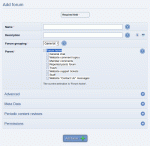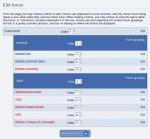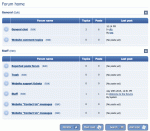Composr Tutorial: Discussion forums
Table of contents
Structure
Adding a forum
When editing forums, the full structure is displayed, with an opportunity to reorder both groupings and sub-forums within
Discussion forums are organized into a hierarchical structure (also known as a tree structure). The forum you view when you visit the discussion forums is the home forum in the hierarchy, and contains child forums (sub-forum s), which may themselves contain child forums, and so on. Within each forum there may also be topic s (known as threads in some other software). And within each topic, there are one or more post s.
Forums are actually a very powerful collaboration tool, not merely limited to chat. For example, ocProducts used a forum as an integral part of the process for the designing of the software you're using right now: it is surprising what forums and topics can be made to represent.
So, now that I have explained the structure of a discussion forum, I will explain what each of these constructs are for.
A forum exists to organise topics into some kind of common subject. For example, it is common for a website to have a debates forum, which contains member-created topics, each representing a single debate. A topic in the debates forum such as a topic titled 'Does extraterrestrial life exist?', contains a number of member-created posts, that together form a continuing line of discussion. A topic gets created, in the most appropriate forum, when a member wishes to discuss something and knows of no topic to continue (by making a new post in); the topic is started with a single post, that leads the discussion, by the member who made the topic.
The sub-forum system exists so that forums may be organised such that subjects are logically sub-classified in such a way as to prevent an 'explosion' of forums displayed on the home forum (which would be cluttered and difficult to navigate). Whether a forum with sub-forums should itself be able to hold topics is up to you, but often allowing this is a useful technique for allowing placement of a topic that classifies under a forum, but not one of the sub-forums.
Add or edit forums from:
Admin Zone > Structure > Forums
You can delete a forum from the bottom of its edit form. The root forum cannot be deleted, however.
Flexibility
While discussion forums are primarily meant for discussion, they may in fact be used for the general purpose of conveying information.
It is often useful for a topic that may-not-be-replied-to be made by staff to convey some form of alert. Why? The discussion forums might be used rather than news, or some other Composr medium, due to the easiness of creating and organising topics, or to target an audience that views the discussion forums more regularly than the other mediums.
Forum groupings
Adding a forum grouping
Add or edit forum groupings from:
Admin Zone > Structure > Forums
You can delete a forum grouping from the bottom of its edit form.
Topics in a forum
Within a forum, there are a number of to modify a topic, to change their behaviour:- A topic may be 'pinned' (also known as 'stickied' in some systems). A pinned topic is placed at the top of the topic list, usually as it contains important information
- A topic may be 'sunk'. This is the opposite of pinning – a sunk topic will display at the bottom of the topic list, on the last page of results
- A topic may be made 'cascading'. Cascaded topics appear in all forums in the forum tree, underneath (and including) the forum they are placed in. The cascade property is often used to make forum-wide announcements
- A topic may be 'closed'. Only those with the necessary privilege may post in a closed topic
- The validation status of a topic (or post) may be changed. Topics that are not validated are only viewable by moderators and the topic creator. Whether topics are automatically set as validated or not depends on permissions (specifically the 'May bypass low-impact validation' permission)
Topics may be moved between forums by moderators.
Strategies for organising your forums
The home forum (i.e. root forum)
A sub-forum of the home forum
Conversr creates a default forum structure which is appropriate for a small or new community. To encourage discussion specific to your site, you may wish to add a new grouping with perhaps 3 forums (sub-forums of the home forum) placed in that grouping.
Using access permissions effectively
Forums use the standard Composr permissions system.All forums define which usergroup have access to them (view access), as well as allowing privilege overrides for each usergroup.
It is common to deny most usergroups any kind of access to certain forums, such as staff forums, in order to make them private to all but select members. Using usergroups (often multiple per member) you then assign access by putting the members in the respective usergroup(s).
The view access check box only gives view access to a forum (not posting access, etc). Likewise, if a forum view access box is unchecked for any particular usergroup that only means there is no view access to the forum for the particular usergroup. Un-checking the forum view access check box does not stop or take away any other permissions – it simply takes away view access for a particular usergroup.
Members have the 'best' permissions when all their usergroups' permissions are considered.
For example: Let's imagine a member is in 3 usergroups, A, B, and C, and usergroup C has the privilege to post in the forum but usergroups A and B do not. That member will be assigned posting access, because the necessary privilege can be found within his/her usergroups.
This is calculated on a permission-by-permission basis. If one of their usergroups grants them certain privileges, and another grants them other privileges, he/she gets the combined set of privileges.
If one usergroup grants view access but not posting privilege, and one usergroup grants posting privilege but not view access, a member in those usergroups gets both.
There is one exception to the above rules: negative privileges overridden against particular forums take precedence over global privileges. For example, if usergroup X is granted the global privilege necessary for posting ("Submit low-impact (medium visibility) content"), but usergroup Y is explicitly denied posting on one particular forum, then a member in those usergroups would not be assigned posting privilege for that particular forum. Overrides always take precedence.
Setting bypass-validation access
By default, forum permissions are set so that members need their posts validating before they show up. This can be changed using Composr's standard permission functionality, but as it is a common task, we thought we'd explain it as an example…You'll need to enable the following global privileges:
- 'Avoid validation (approval) for low-impact content', if a member is to be able to post without requiring validation
- 'Avoid validation (approval) for mid-impact content', if a member is to be able to create a topic without requiring validation
You can set them in 3 places (in order from highest level to lowest level):
- In the 'Submission' set of the global privilege settings (go to Admin Zone > Security > Privileges > Submission)
- Or, you can use the Permissions Tree Editor (go to Admin Zone > Security > Permissions Tree Editor) to set these on the forum zone's forumview module (if you don't want these to apply for any other 'mid-impact content' across the site)
- Or, you can set them against specific forums using either the Permissions Tree Editor or the editing screen of a forum
This flexibility is very intentional – you have a choice of setting things at a high level to apply to the whole website, but also the choice to make overrides at a lower level.
Anonymous posting
Members have a feature where they can choose to post anonymously. If they do this, their post will show as a guest post.If you see guest posts somewhere where guests cannot post then this is probably why.
Staff can track which user made the post via clicking on the 'Guest' label and hence investigating the IP address. This is no different to an investigation on a normal Guest post.
Replying
Quick reply
If your users are confused by the quick reply function (for example, they miss the WYSIWYG), you can turn off the 'Use quick reply' privilege for them.
Topic polls
Viewing a poll (post-voting)
Viewing a poll (pre-voting)
Adding a poll
- viewing of poll results until the poll is 'un-blinded'
- voting, such that that members must reply to the topic of the poll before they may vote in it
Editing posts
There is an edit post button underneath each post.If you edit a post then you get to choose whether it shows as edited or not. The default is for this option to be checked unless you edit quickly (within 3 minutes). The special case here is because we assume that the edit is a quick correction rather than being a retraction that should be advertised.
Staff can view full post history: edits aren't secret from staff.
Deleting posts
There is a delete post button underneath each post.If somehow a corrupt post makes it through and obscures the delete button after it, you can manually delete (or edit) it from the edit URL:
http://yourbaseurl/forum/index.php?page=topics&type=edit_post&id=<postid>
You can find the post ID from above (before) the post in the topicview.
Conversr versus other forum software
Conversr was designed to be a powerful forum in its own right.Here are some features we have in Conversr that are mostly unique across forum software:
- Blind polls (results hidden until voting ends)
- Private topics, rather than primitive private messages
- Inline private posts (private messages embedded in public forum topics, so people can make private remarks to each other)
- Forum introduction questions (a much more general concept than the silly 'password protected' forums, which duplicate what usergroup permissions are for)
- True tree structure for forum, and cascading topics that can show as pinned just for a subtree (e.g. have a pinned topic under all the 'Games' forums, but not under the 'Politics' forums)
- Sinking topics (the opposite of pinning)
- Reported post forum (so moderators can discuss reported posts as part of their normal forum workflow, rather than them being stored elsewhere)
- Clubs (so members can create their own usergroups and forums)
- JavaScript overlay for profile info next to posts, rather than having repetitive information placed everywhere
- Integrated moderation function (no separate modcp needed)
- Post history (so you can see if people edited old posts in a debate for example)
- Welcome messages (so you can define a series of mailings to welcome new members)
- Important posts (a moderator can highlight a post in a topic to make a clear point)
- Post templates (so the forum can be used like a help desk)
- Integrated rank/usergroup system (because having rank and usergroup separate just gets confusing)
Since the time of Conversr's development, standalone forums have actually reduced a lot in popularity, for the same reasons that we decided tight integration was the way to go – a consistent user experience across a whole website is the way to go, instead of having community features mostly siloed off on some separate piece of software. That ended up being called 'Web 2.0' and then 'Social media', but it basically is what Composr's philosophy always has been: an interactive and integrated cross-website experience. However most "new forums", written from scratch to provide this tight integration, are cut down in functionality and lack a lot of really important features, while we've matched and raised the functionality at the same time as properly integrating it. This is one thing we're quite proud of about with Composr: we don't just throw away proven functionality to create the new, we embrace established concepts and build industry innovations right into the core of it all.
Concepts
- Discussion forums
- A system for discussing issues; topics contain posts, and topics are placed within forums which themselves are structured
- Forum
- A place for the archiving and posting of topics (discussions)
- Sub-forum
- A forum underneath another forum in the forum tree structure
- Forum grouping
- A categorisation of a forum, distinct from the tree structure
- Topic
- A sequence of posts
- Post
- A piece of writing made by a user and displayed as a continuation, or start, of a topic
- Pin
- A pinned topic is displayed above a non-pinned topic (otherwise, date order is used for sorting)
- Sunk
- A sunk topic is displayed beneath all other topics
- Cascade
- A cascading topic is displayed in its forum, and all subforums there-of
- Home forum
- The forum at the root of the forum tree structure
See also
Feedback
Have a suggestion? Report an issue on the tracker.










